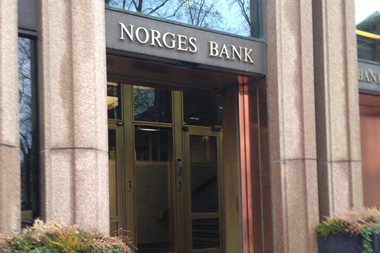Norway’s finance ministry has decided that the management of the country’s NOK8.1trn (€858bn) oil fund should remain within the central bank, rejecting an idea under formal discussion since June 2017 to spin off the operation.
The announcement comes after consultation on a proposal put forward that the fund, the Government Pension Fund Global (GPFG) – currently managed by central bank arm Norges Bank Investment Management (NBIM) – be managed by a statutory entity de-merged from Norges Bank.
Finance minister Siv Jensen said: “After a comprehensive assessment, the government recommends that Norges Bank continue to be the asset manager of the GPFG going forward.”
The ministry said it had submitted a white paper today to the Norwegian parliament (Stortinget) recommending this, and was also proposing to establish a committee for monetary policy and financial stability in Norges Bank.
Explaining the decision to keep the oil fund’s management in the central bank, the ministry said Norges Bank was an institution that enjoyed a high level of trust, both in Norway and internationally, and that over time its performance, both as asset manager for the GPFG and as Norway’s central bank, had been good.
As the central bank, Norges Bank also had a thorough understanding of the role the GPFG played in economic policymaking, the ministry said.
At the end of June, the Commission on the Act relating to Norges Bank and the Monetary System, chaired by Svein Gjedrem, reasoned in its report that the bank’s twin tasks – central banking and investment management – had grown over the years and were now putting greater demands on the board, senior management, and the organisation.
The two activities differed in nature and having two distinct bodies to manage them would mean the skills within each could be more easily tailored to the particular tasks involved, Gjedrem said when the report was published.
Governance rejig
In the announcement today, Jensen acknowledged that keeping the management of the fund in Norges Bank meant the bank would continue to have broad and complex responsibilities.
“We must ensure that the governance structures are well adapted to these responsibilities,” she said.
“By moving responsibility for these tasks to a separate committee, the board of the central bank can become more focused on […] the bank’s other tasks, in particular management of the GPFG.”
Norwegian finance ministry
To this end, the ministry said the government was proposing to establish a policy committee within the bank, which would take decisions on the key policy rate and advise on the counter-cyclical capital buffer and other matters.
“By moving responsibility for these tasks to a separate committee, the board of the central bank can become more focused on and devote more time to the bank’s other tasks, in particular management of the GPFG,” the ministry said.
Norges Bank’s governor Øystein Olsen commented on the white paper, saying that keeping the GPFG’s management within his organisation and creating an expert committee for monetary policy and financial stability was an idea to which the bank had already declared itself open.
“I have previously pointed out that Norges Bank is well equipped to continue its mission in both areas,” he said.
The finance ministry said today that the government intended to put forward a legislative proposal based on the white paper in spring 2019.























No comments yet